
There is a growing interest in the field of developing intelligent, self-forming data networks in the industrial and domestic instrumentation and control arenas. The primary application for such networks is that of data-acquisition such as meter-reading, parametric display of temperature, pressure, movement etc. Some element of control is also part of the envisioned functionality.
This is not a new idea and indeed such applications already exist. The real barrier to the widescale adoption of this type of technology has historically been current consumption and unit cost. Nordic Semiconductor has, with the release of its 'E' series of intelligent transceivers, offered a family of products that offers an unrivalled solution to these challenges.
Small-scale independent intelligence
What is today's primary challenge? The applications that can benefit from a wireless solution are typically low transmission activity devices. This is typically applications such as temperature controllers, alarms and other units that trigger information transactions on reasonably infrequent events, or based on a polling system. Therefore, to develop a system that can carry out these functions, independent intelligence is required at all nodes in the network. However, there is a balancing act to be resolved here. Bluetooth, for example, has latency issues and excessive current consumption due to its inherent design. Unit cost has also never realistically dropped to the 'magical $5,00 point'. This effectively rules out Bluetooth for such applications.
Zigbee is another proposed solution, but as of May 2005, was not yet a ratified standard. The system is already demanding 32K to 128K stack size for a master node, at this early stage this figure is much more likely to grow rather than decrease.
The 'E' series devices currently available from Nordic Semiconductor are an ideal fit for proprietary networks in terms of performance and cost. This includes a transceiver system incorporating MAC layer addressing and CRC error correction. In addition, the single device houses a 4K 8051 microcontroller and a 9-channel, 10-bit ADC and a pulse width modulator (PWM). This is adequate to develop simple star or tree networks and to implement the application functionality.
The key to an economically-viable product is to obtain the optimal tradeoff between complexity and simplicity sufficient to achieve reliable wireless functionality, but yet keep target cost and current consumption to a minimum.
ZigBee and IEEE 802.15.4
There is currently some confusion surrounding the pending introduction of ZigBee devices into the marketplace and their relation to the IEEE 802.15.4 standard. It is important to differentiate ZigBee from IEEE 802.15.4. The IEEE standard 802.15.4 describes the specification for radio PHY (RF physical) and MAC (medium access control) layers at 2,4 GHz, 868 MHz and 915 MHz. ZigBee has adopted this standard for the basis of its own communications standard, however, they are not one and the same, and appear as separate entities in terms of hardware and software.
Therefore, to clarify the current situation, transceivers are being produced that operate according to the IEEE 802.15.4 standard, and a ZigBee stack is usually implemented by a separate vendor in an external microcontroller or processor.
Interoperability issues
Currently there is a push for a unified standard that promises a singular world of seamless interoperability between products from different vendors. Bluetooth was conceived in a joint effort in order to achieve just this. It is today considered to be a mature technology but interoperability issues are still not totally eradicated. The Bluetooth standard has a rigorous qualification procedure to ensure that application interoperability is achieved. ZigBee at present has no such requirement. The practical challenge is how to ensure that your home climate controller will speak the same language as the third party thermostat purchased to work with it? Indeed, should compatibility problems arise, there is the risk that your product shoulders as much blame as the offending device. In short, a standard without qualification requirements opens the door for profiteers to introduce cheap, substandard products with limited compatibility.
Many developers will prefer to have their own proprietary system, enabling in each vendor's opinion, a superior system that customers will want to buy. It is not necessarily in a product manufacturer's interest to allow customers to choose a competitor's product. The adherence to groups such as ZigBee is a liability as well as a possible opportunity. Standards can be limiting and reduce the degrees of freedom available to the application developers in the design process. A product manufacturer will have to consider all the possible devices from competitors that may be interfaced with their own system. This alone can reduce the overall communication efficiency of a system if interfacing products supplied by other vendors are not efficient.
Bandwidth efficiency
The IEEE 802.15.4 standard is based on a direct sequence spread spectrum (DSSS) technology. DSSS has good interference resistance characteristics, but this does not come for free. DSSS coding means that the price paid for improved interference resistance is greater RF bandwidth consumed per transmitted data bit.
For the nRF24xx devices operating at 2,4 GHz, channel occupancy for 1 Mbps is 1 MHz resulting in 1 bit/Hz bandwidth efficiency. For IEEE 802.15.4, it is 250 Kbps over 3 MHz resulting in 0,83 bit/Hz. The nRF24x1 devices can thus support 83 independent frequency channels for collision avoidance, as opposed to the 16 independent channels available under the IEEE 802.15.4 scheme.
Similarly, in the 868 MHz frequency band for European operation, IEEE 802.15.4 offers one channel for all communication at a maximum datarate of 20 Kbps. In contrast, the nRF905 can support seven independent channels at 50 Kbps per channel. The channel allocation for these two bands and corresponding data-rates are illustrated in Figure 1a and Figure 1b.
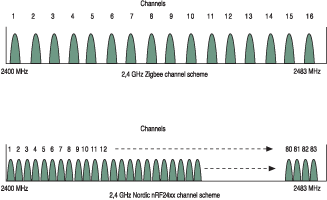
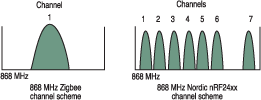
The nRF24xx and nRF9xx devices have been developed to enable MAC level protocol processing on-chip. At the same time this has been kept as lightweight as possible to ensure minimum on-air time. This can be illustrated by comparing an IEEE 802.15.4 transmission packet and a typical low datarate nRF data packet. In this example, a payload of 32 bit is used, the payload consisting of a 16-bit temperature reading and two addition bytes of control information. To encapsulate this into a packet, an additional 8 bits of preamble, 32 bits of addressing and 8 bits of CRC error-checking are included, adding up to a total of 72 bits of data required in the data package. The same information transfer under IEEE 802.15.4 would require a total of 152 bits.
Packet assembly for the Nordic nRF device:
* 8 bit preamble.
* 32 bit address ID.
* 32 bit data payload.
* 8 bit CRC.
The same packet function in an IEEE 802.15.4 compatible device would require the following contents:
* 32 bit preamble.
* 8 bit frame de-limiter.
* 8 bit frame length.
* 16 bit frame control.
* 8 bit data sequence number.
* 32 bit address ID.
* 32 bit data payload.
* 16 bit frame checksum.
This example lists the typical contents of a communication package that would be delivered on a low datarate, low activity network (32 bits of data payload). For a typical short range application, the nRF datarate is also four times higher than an IEEE 802.15.4 compatible device. Therefore in this scenario the nRF device will be consuming just 12,5% of the battery power required for an IEEE 802.15.4 device.
Just as important, the nRF device will be on the air for only 12,5% of that of the IEEE 802.15.4 device. This will in turn reduce the probability of collision incidences. Figure 2 shows the communication efficiency as a function of packet size for a nRF24xx and the ZigBee alternative. This example has not taken into account the typically larger current consumption incurred by a separate microcontroller that is required to operate with an IEEE 802.15.4 compatible transceiver.
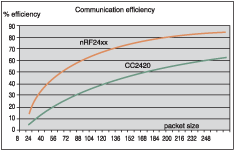
System compactness in design
The high integration level of the nRF 'E' series devices results in unrivalled compactness needed for area/volume critical applications. The entire system can be fitted within the physical outline of a button cell battery and still have battery lifetimes in terms of years for low data duty-cycle applications typically targeted by ZigBee. A complete functional system as shown in Figure 3 can fit into designs with a footprint of less than 20 x 15 mm. All 'E' series devices have on-chip ADC functionality as well as ample supply of digital ports for interfacing to the outside world, be it analog or digital.
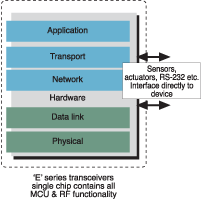
Therefore, one can see that an entire system from the RF physical layer up to application software can be implemented in a simple, single-device unit.
Alternatively, current ZigBee solutions are running the RF physical and MAC layers in one device, and all further processing and application functionality is carried out in a separate, medium-range microcontroller device. This has greater current demands and the minimum footprint will consequently be exceeding that of the Nordic nRF 'E'-series devices.
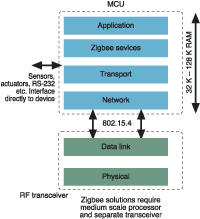
Communication reliability
A wireless network with independent nodes will inevitably experience collisions in terms of nodes trying to communicate at the same time resulting in overlapping communication packages. The probability of collision is dependent on the number of nodes in the network, polling/reporting frequencies, transfer data-rate and the actual size/format of the communication packages. The activity of other wireless devices operating in the same frequency band will also increase the probability of communication collision causing destructive interference.
The IEEE 802.15.4 and the nRF devices have dissimilar approaches to achieving reliable communication in an environment where collisions are to be expected.
The IEEE 802.15.4 standard is based on a DSSS topology which is known for its higher tolerance of in-band noise. This means that such a device may handle a certain amount of interference on the same channel without data being lost. How well a DSSS transceiver performs under the presence of noise is dependent of the power and noise characteristics of the interferer and the processing gain of the DSSS transceiver. In addition, the quality of the transceiver front end influences the overall performance. It should be noted that the term 'noise immunity' frequently used for DSSS transceivers is a misconception as it is by no means immune to in-band noise. Frequency restrictions in the European 868 MHz band limit the processing gain of the IEEE 802.15.4 standard, resulting in a lower noise tolerance than experienced in traditional DSSS systems.
The most prominent cost of DSSS in this context is lower data-rate and thus a higher overall traffic in the band due to longer duration of the data packages. Consequently, this also leads to increased current consumption. Another issue is the reduced ability to handle peak traffic in a network operating at the 868 MHz single channel band.
The nRF devices are based on an entirely different approach. The concept is to transfer data at the highest possible datarate with a bandwidth efficient modulation method. The result is faster data transfer resulting in less occupancy of the wireless medium and also allows a much higher number of alternative transmission channels in case of presence of interference or 'friendly' traffic. The cost is a higher vulnerability to in-band interference.
However, it should be noted that the occupied bandwidth is narrow due to GFSK-modulation. Due to the high datarate, the probability of data collisions is reduced accordingly. Collisions are detected earlier and data can be transferred at alternative channels, or at a later time instant. Battery power consumption is also minimised due to the short transmit-times.
Conclusion
This article has attempted to help draw the distinction between IEEE 802.15.4 functionality and the ZigBee protocol stack. This is highlighted by the fact that typically, IEEE 802.15.4 is implemented in hardware on a transceiver device, whereas ZigBee is implemented on a medium-scale microcontroller in addition to the aforementioned transceiver.
With this distinction set aside, a comparison has been drawn between a IEEE 802.15.4 compatible transceiver device and the Nordic nRF24xx and nRF9x5 'E' series devices, the latter incorporating both transceiver and small microcontroller with a 10 bit ADC.
The envisioned functionality of low data-rate, low activity sensor networks is to provide reliable communication and yield battery lifetimes that are measured in years as opposed to months. It has been shown that typically the nRF family of devices can offer both current consumption and time-on-air periods a mere 12% of an equivalent IEEE 802.15.4 compatible device. An important factor is the ability of the nRF 'E' devices to operate down to 1,8 V supply voltage. This permits a tolerated voltage drop as much as 1,2 V from a typical 2 x AAA battery set, whereas a standard 2,7 V device will tolerate only 0,3 V voltage drop. This fact will also play a critical role in the effort of achieving year-period battery lifetimes.
The IEEE 802.15.4 and the nRF devices have dissimilar approaches to achieving reliable communication in an environment where collisions and interference is to be expected. The IEEE 802.15.4 is based on high interference tolerance, whilst the nRF devices are based on short duration data transfer and high frequency agility.
Performance figures indicate that very capable, reliable and extremely current-economical systems can be implemented with Nordic nRF devices.
| Tel: | +27 11 854 5011 |
| Email: | [email protected] |
| www: | www.khd.co.za |
| Articles: | More information and articles about KH Distributors |

© Technews Publishing (Pty) Ltd | All Rights Reserved